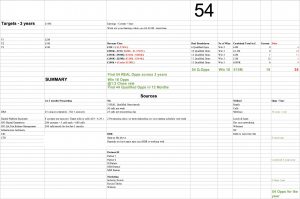
Welcome back to Part 4, as a pre – requisite to this blog, I would recommend you reviewing Part 1, Part2 and Part 3 of the series. For this part, we will be reviewing how to set your opportunity targets for each channel.
Lets recap the formula from Part 2 of the series ” Sales Planning For Success”
Target = ACV x NOD
NOD= Opps x close ratio
Using the same numbers, if you need 6 Closed opps ( NOD) and your opp close rate ( close ratio ) is 25% for new business ( remember this whole exercise is for you to build your business from scratch), then you need around 24 opps for the year.
- The question you need to ask yourself is, how many opps can you find yourself?
- How many opps would you expect from your internal and external channels?
E.g – depending on your activity levels if you could identify 2 opps a month, you would effectively have 24 opps within 12 months.
Now, this has not taken into account the opps that you may qualify out however, this could be offset by the opps you would receive from your other channels.
Yearly breakdown
This is an example of a breakdown, based on yearly channels for opportunities:
Internal Channels-
- Me – 24 opps
- SI – 2 opps
- MSP – 2 opps
- Resellers – 2 opp
- OEM – 2 opps
- Total = 32 opps
External Channels-
- Events – 2 opps
- Marketing – 2 opps
- BDR – 4 opps
- Total 8 opp
Combined Total= 40 opps
Applying your opp close rate of 25% to this means you have the potential to close 10 deals in the year. With an ACV of £250K means you can finish the year on £2.5M which is 250% of your annual target ( assuming your annual target is £1Million).
We should remember, this is the theory and the science, the real magic is manifested when we are diligent, focussed, execute laser eye execution and with regular evaluation of our plan.
In the next section, we will explore how we incorporate the above into a business plan and how we breakdown these opportunities into daily activities.
Road to Target: this shows an example of a plan I leveraged a few years ago:

This is my dashboard, and the control tower within my business plan. Let’s review the key headings:
Targets – as you can see from the image above, I have devised a 3 year plan with my personal revenue target of £10M. This is then broken down into 3 realistic yet ambitious chunks, I have applied the SMART objectives here.
One may ask how I arrived at this, well, this figure was chosen, based on my earnings goal for the next 3 years using the commission calculator shared by my employer at the time.
This means, I know to the penny how much I would earn ( before tax deductions) when I reach this revenue goal.
The figure “54” represents how many qualified opportunities I need in 3 years, applying my close ratio to this “54” opportunities would mean I will arrive at my revenue goal and ultimately my earnings target.
Reverting back to our underlying formula (T= ACV x NOD), I have broken down the various range of my ACV.
Revenue tiers -This is the next stage of being pragmatic around the types of opportunities we need to be seeking.
Deals breakdown – this represents the number of opportunities that I need to seek within the revenue range. In the scenario above this number is 54.
No of wins – the maths here is fairly straightforward, how many of these opportunities do you need to win in this range in order to achieve your total revenue goal. In the scenario above this no is 18.
Combined total – this related to the total amount of revenue for your “no of wins”. In the scenario above this revenue target is £10M.
Current – the number of current qualified opportunities in your pipeline. In the scenario above this number is 19.
Delta – your shortfall, worked out as the difference between the opportunities you need and takeaway your current. In the scenario above this number is 35.
Summary – Find 54 opportunities, with a close rate of 1:3 you end up winning 18 opportunity. These 18 opportunities would yield you the £10M revenue goal should you find the opportunities in the tiers specified.
Now let’s take a look at the sources ( refer to the image above)breakdown, as you can see, the columns have been entitled as:
- Job titles, 1st 3 months, Me/BDR/Partners&SI/Marketing, Methods, Opps/Year
At this stage I’m pretty certain you’ve managed to work this out yourself however, allow me to offer you a brief summary of my thinking process behind this.
Job Titles – as sales reps our biggest asset is time, effective and efficient use of our time would produce significant results. This stage of the process requires a thorough understanding of your companies “value proposition”. This becomes a vehicle to help you define which job titles within a particular company on your target list would listen to you or have a real business challenge that your value proposition would solve.
1st 3 Months – prospecting is an ever revolving process which should never cease. You may be wondering why this has been entitled “1st 3 months”, well, this “1st 3 months” would give you the opportunity to evaluate your activity and strategy, thereby, giving you the opportunity to evaluate and make changes in case you need to recalibrate.
The goal here is to end up on a daily number for how many calls you need to make in a month, week and daily basis. Let’s review the maths here:
- 25 unique companies, 8 contacts per company
- Equates to 200 contacts, with 3 calls per contact ( unique phone calls )
- Equates to 600 calls, break this down into 3 months of 200 calls each month
For me this meant 50 calls per week and 25 calls per day as I had 2 days allocated to prospecting. These 25 calls are well planned with a fair amount of research on the company and my contacts.
Me – remember the “channels for generating opportunities” in Part 3 of this series , this is a succinct summary which says I ( Me ) need to generate 3 opportunities every month as my goal. How am I going to achieve this?.
I will achieve this by strict adherence to the summary of 200 calls per month, 50 calls per week and 25 calls per day with 2 prospecting days per week.
BDR – I have devised this same strategy and targets with my BDR who supports me. In turn I offer my support through mentoring, joint call out days and helping them achieve their goal of moving into field sales.
Partners & SI – breakdown of my partners and SI ( System Integrators).
Methods – which prospecting methods I plan on adopting, in this case I will be using calling, emails, lunch and learns, networking events etc.
Opps/year – I have reversed engineered my opportunity allocations here. Taking the number 54, and taking away how many I will generate for the year, I’m able to now assign a forecast for the remainder of my channels.
I really hope you are able to comprehend this, this is quite profound, and I appreciate it may not make sense to everyone. If you feel the need for further explanation, feel free to contact me at mike@metricdrivenselling.com.
Part 5 would look at the “Activities” in detail and how we actually ensure these channels works for us, in generating qualified opportunities.
To Our Growth
Mike

